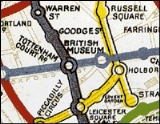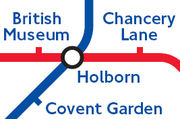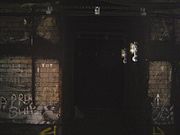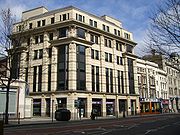
British Museum tube station
Encyclopedia
British Museum tube station was a station on the London Underground
's Central Line
, located on Bury Place, close to the British Museum
in central London
, England
.
(CLR) with its entrance located at 133 High Holborn (now the Nationwide Building Society), near the junction of High Holborn
and New Oxford Street. In December 1906, Holborn
station was opened by the Great Northern, Piccadilly and Brompton Railway
(GNP&BR, now the Piccadilly line
) less than a hundred yards away. Despite being built and operated by separate companies, it was common for the underground railways to plan routes and locate stations so that interchanges could be formed between services. This had been done by other lines connecting with the CLR stations at Oxford Circus
and Tottenham Court Road
, but an interchange station was not initially constructed between the GNP&BR and the CLR because the tunnel alignment to British Museum station would not have been suitable for the GNP&BR's route to its Strand station
(later called Aldwych). The junction between High Holborn and the newly constructed Kingsway was also a more prominent location for a station than that chosen by the CLR.
 The possibility of an underground passageway was initially mooted, but the idea suffered from the complexity of tunneling between the stations, and the long walking distance it would involve (no-one considered moving walkway
The possibility of an underground passageway was initially mooted, but the idea suffered from the complexity of tunneling between the stations, and the long walking distance it would involve (no-one considered moving walkway
s at the time). Holborn station was, in any case, better situated than British Museum, as it had better tram
connections (Holborn had a stop
on the now defunct Kingsway tramway subway
). A proposal to enlarge the tunnels under High Holborn to create new platforms at Holborn station for the CLR and to abandon British Museum station was originally included in a private bill
submitted to parliament by the CLR in November 1913, although the First World War prevented any works taking place. The works were eventually carried out as part of the modernisation of Holborn station at the beginning of the 1930s when escalator
s were installed in place of lifts
. The station was duly closed on 24 September 1933, with the new platforms at Holborn opening the following day.
British Museum station was subsequently re-used up to the 1960s as a military administrative office and emergency command post, but it is now wholly disused. It can no longer be accessed from the surface and the surface building was demolished in 1989. The platforms have now been removed, thus lowering the entire tunnel floor to track level. This portion of the eastbound tunnel is now used by engineers to store sleepers
and other parts of track, which can be seen from passing trains.


London Underground
The London Underground is a rapid transit system serving a large part of Greater London and some parts of Buckinghamshire, Hertfordshire and Essex in England...
's Central Line
Central Line
The Central line is a London Underground line, coloured red on the tube map. It is a deep-level "tube" line, running east-west across London, and, at , has the greatest total length of track of any line on the Underground. Of the 49 stations served, 20 are below ground...
, located on Bury Place, close to the British Museum
British Museum
The British Museum is a museum of human history and culture in London. Its collections, which number more than seven million objects, are amongst the largest and most comprehensive in the world and originate from all continents, illustrating and documenting the story of human culture from its...
in central London
London
London is the capital city of :England and the :United Kingdom, the largest metropolitan area in the United Kingdom, and the largest urban zone in the European Union by most measures. Located on the River Thames, London has been a major settlement for two millennia, its history going back to its...
, England
England
England is a country that is part of the United Kingdom. It shares land borders with Scotland to the north and Wales to the west; the Irish Sea is to the north west, the Celtic Sea to the south west, with the North Sea to the east and the English Channel to the south separating it from continental...
.
History
It was opened on 30 July 1900 by the Central London RailwayCentral London Railway
The Central London Railway , also known as the Twopenny Tube, was a deep-level, underground "tube" railway that opened in London in 1900...
(CLR) with its entrance located at 133 High Holborn (now the Nationwide Building Society), near the junction of High Holborn
High Holborn
High Holborn is a road in Holborn in central London, England. It starts in the west near St Giles Circus, then goes east, past the Kingsway and Southampton Row, and continues east. The road becomes Holborn at the junction with Gray's Inn Road....
and New Oxford Street. In December 1906, Holborn
Holborn tube station
Holborn is a station of the London Underground in Holborn in London, located at the junction of High Holborn and Kingsway. Situated on the Piccadilly Line and on the Central Line , it is the only station common to the two lines, although the two lines cross each other three times elsewhere...
station was opened by the Great Northern, Piccadilly and Brompton Railway
Great Northern, Piccadilly and Brompton Railway
The Great Northern, Piccadilly and Brompton Railway , also known as the Piccadilly tube, was a railway company established in 1902 that constructed a deep-level underground "tube" railway in London. The GNP&BR was formed through a merger of two older companies, the Brompton and Piccadilly Circus...
(GNP&BR, now the Piccadilly line
Piccadilly Line
The Piccadilly line is a line of the London Underground, coloured dark blue on the Tube map. It is the fifth busiest line on the Underground network judged by the number of passengers transported per year. It is mainly a deep-level line, running from the north to the west of London via Zone 1, with...
) less than a hundred yards away. Despite being built and operated by separate companies, it was common for the underground railways to plan routes and locate stations so that interchanges could be formed between services. This had been done by other lines connecting with the CLR stations at Oxford Circus
Oxford Circus tube station
-External links:* ** ** * Plans of the station after the Victoria Line works , , *...
and Tottenham Court Road
Tottenham Court Road tube station
Tottenham Court Road is a London Underground station in central London. It is an interchange between the Central line and the branch of the Northern line.On the Central line it is between and , and on the Northern line it is between and...
, but an interchange station was not initially constructed between the GNP&BR and the CLR because the tunnel alignment to British Museum station would not have been suitable for the GNP&BR's route to its Strand station
Aldwych tube station
Aldwych is a closed London Underground station in the City of Westminster, originally opened as Strand in 1907. It was the terminus and only station on the short Piccadilly line branch from Holborn that was a relic of the merger of two railway schemes. The disused station building is close to the...
(later called Aldwych). The junction between High Holborn and the newly constructed Kingsway was also a more prominent location for a station than that chosen by the CLR.

Moving walkway
A moving walkway or moving sidewalk is a slow moving conveyor mechanism that transports people, across a horizontal...
s at the time). Holborn station was, in any case, better situated than British Museum, as it had better tram
Tram
A tram is a passenger rail vehicle which runs on tracks along public urban streets and also sometimes on separate rights of way. It may also run between cities and/or towns , and/or partially grade separated even in the cities...
connections (Holborn had a stop
Holborn tramway station
Holborn tramway station was a tram stop underneath Kingsway in central London. It was built in 1906 by the London County Council Tramways as part of the Kingsway tramway subway, a subterranean tram route which was constructed to join the separate networks of tramways in North and South London...
on the now defunct Kingsway tramway subway
Kingsway tramway subway
The Kingsway Tramway Subway is a cut-and-cover Grade II Listed tunnel in central London, built by the London County Council, the only one of its kind in Britain...
). A proposal to enlarge the tunnels under High Holborn to create new platforms at Holborn station for the CLR and to abandon British Museum station was originally included in a private bill
Local and Personal Acts of Parliament in the United Kingdom
Local and Personal Acts of Parliament are laws in the United Kingdom which apply to a particular individual or group of individuals, or corporate entity. This contrasts with a Public General Act of Parliament which applies to the entire community...
submitted to parliament by the CLR in November 1913, although the First World War prevented any works taking place. The works were eventually carried out as part of the modernisation of Holborn station at the beginning of the 1930s when escalator
Escalator
An escalator is a moving staircase – a conveyor transport device for carrying people between floors of a building. The device consists of a motor-driven chain of individual, linked steps that move up or down on tracks, allowing the step treads to remain horizontal.Escalators are used around the...
s were installed in place of lifts
Elevator
An elevator is a type of vertical transport equipment that efficiently moves people or goods between floors of a building, vessel or other structures...
. The station was duly closed on 24 September 1933, with the new platforms at Holborn opening the following day.
British Museum station was subsequently re-used up to the 1960s as a military administrative office and emergency command post, but it is now wholly disused. It can no longer be accessed from the surface and the surface building was demolished in 1989. The platforms have now been removed, thus lowering the entire tunnel floor to track level. This portion of the eastbound tunnel is now used by engineers to store sleepers
Railroad tie
A railroad tie/railway tie , or railway sleeper is a rectangular item used to support the rails in railroad tracks...
and other parts of track, which can be seen from passing trains.
The station in popular culture

- In the Neil GaimanNeil GaimanNeil Richard Gaiman born 10 November 1960)is an English author of short fiction, novels, comic books, graphic novels, audio theatre and films. His notable works include the comic book series The Sandman and novels Stardust, American Gods, Coraline, and The Graveyard Book...
novel NeverwhereNeverwhereNeverwhere is an urban fantasy television series by Neil Gaiman that first aired in 1996 on BBC Two. The series is set in "London Below", a magical realm coexisting with the more familiar London, referred to as "London Above". It was devised by Neil Gaiman and Lenny Henry, and directed by Dewi...
the main character, Richard Mayhew, a Londoner, protests that there is no British Museum Station - only to be proved wrong when the train he is on stops there. - The station was mentioned in the 1972 horror film Death LineDeath LineDeath Line is a 1972 British horror film, distributed as Raw Meat in the United States. The film stars Donald Pleasence as Inspector Calhoun, and was directed by the American filmmaker Gary Sherman.-Plot:...
, but contrary to popular belief, it is not the station portrayed in the film as being the home of a community of cannibals descended from Victorian railway workers. The cannibals venture out at night to snatch travellers from the platforms of operating stations and take them back to their gruesome 'pantry' at an incomplete station. Donald PleasenceDonald PleasenceSir Donald Henry Pleasence, OBE, was a British actor who gained more than 200 screen credits during a career which spanned over four decades...
stars as the investigating police inspector, and when finally cornered, one of the cannibals screams a corrupted form of "Mind the doors!", obviously having picked it up parrot-fashion from the guards on the Underground trains. The station in question is named simply 'Museum' and is clearly stated as being 'between' Holborn and British Museum stations in a conversation between Pleasance's character and a colleague. It is supposedly part of a completely separate line that was not completed owing to the construction company going bankrupt. Signs in the abandoned station also only state 'Museum' as the name.

- The station did feature in the Bulldog DrummondBulldog DrummondBulldog Drummond is a British fictional character, created by "Sapper", a pseudonym of Herman Cyril McNeile , and the hero of a series of novels published from 1920 to 1954.- Drummond :...
spin-off film Bulldog JackBulldog JackBulldog Jack is a 1935 film produced by Gaumont International, directed by Walter Forde, and starring Jack Hulbert, Fay Wray, Ralph Richardson; it also starred Atholl Fleming as Bulldog Drummond....
(not a Sherlock HolmesSherlock HolmesSherlock Holmes is a fictional detective created by Scottish author and physician Sir Arthur Conan Doyle. The fantastic London-based "consulting detective", Holmes is famous for his astute logical reasoning, his ability to take almost any disguise, and his use of forensic science skills to solve...
film, as some sources claim), as the location reached by a secret tunnel leading from the inside of a sarcophagusSarcophagusA sarcophagus is a funeral receptacle for a corpse, most commonly carved or cut from stone. The word "sarcophagus" comes from the Greek σαρξ sarx meaning "flesh", and φαγειν phagein meaning "to eat", hence sarkophagus means "flesh-eating"; from the phrase lithos sarkophagos...
in the British Museum. The villain (Ralph RichardsonRalph RichardsonSir Ralph David Richardson was an English actor, one of a group of theatrical knights of the mid-20th century who, though more closely associated with the stage, also appeared in several classic films....
) was finally cornered and forced into a sword duel on the disused platforms, which were a studio set. The station was renamed 'Bloomsbury' in the film. - The station briefly featured in the computer game Broken Sword: The Smoking Mirror, in which Nico Collard escapes from the British Museum and finds the station. She then manages to stop the passing trains. The station in the game, however, is depicted as having its exit actually inside the British Museum itself. A station named Museum also features in the earlier game Beneath a Steel SkyBeneath a Steel SkyBeneath a Steel Sky is a 1994 science-fiction point-and-click adventure game in the cyberpunk genre. Like many point-and-click adventure games, it features comedy elements, and was developed by Revolution Software, a British developer, and published by Virgin Interactive Entertainment. It was...
, by the same company, but the apparent Australian setting for the latter game, as well as its proximity to a station named "St James" suggests this is actually Museum railway station, Sydney. - The station is mentioned in the novel Tunnel Vision by Keith LoweKeith LoweKeith Lowe is a British author. His first novel, Tunnel Vision , follows a man who is challenged to visit every station of the London Underground in a single day. His second novel is New Free Chocolate Sex .Lowe grew up in Hampstead in London, sharing a bedroom with four brothers and a sister...
. It mentions that a restaurant is on the site of the old station, of which there is nothing left. - The station appears in 'Pornography' by Simon Stephens. A brother takes his sister there saying, 'It's for the British Museum. It's not been used for sixty years. They closed it because there was no need of it any more. With Holborn and Tottenham Court Road.' The sister says, 'You can imagine the people... Standing there.'
- The station is reputed to be haunted by the ghost of the daughter of an Egyptian Pharaoh called Amen-Ra which would appear and scream so loudly that the noise would carry down the tunnels to adjourning stations.

